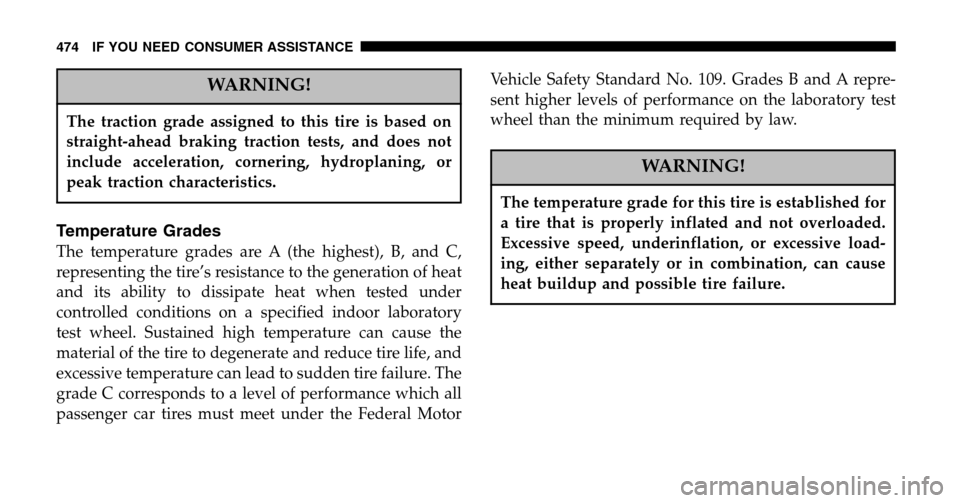Page 379 of 496

10. Lower the vehicle by turning the jack screw to the
left.
11. Finish tightening the lug nuts. Push down on the
wrench while tightening for increased leverage. Alternate
lug nuts until each nut has been tightened twice. Correct
wheel nut tightness is 130 N·m (95 ft. lbs). If in doubt
about the correct tightness, have them checked with a
torque wrench by your dealer or at a service station.
12. Lower the jack to its fully closed position.
13. Secure the flat tire as follows:
•Place the deflated (flat) tire and compact spare tire
cover assembly in the rear cargo area, have the tire
repaired or replaced as soon as possible.
WARNING!
A loose deflated (flat) tire thrown forward in a
collision or hard stop could injure the occupants in
the vehicle. Have the deflated (flat) tire repaired or
replaced immediately.
CAUTION!
Vehicle damage will occur if the compact spare tire
cover assembly is installed without the compact
spare tire in position. Place the deflated (flat) tire
and compact spare tire cover assembly in the rear
cargo area.
WHAT TO DO IN EMERGENCIES 379
6
Page 383 of 496

CAUTION!
For vehicles equipped with Stow ’n Go seating, the
Winch Mechanism is designed specifically to stow a
COMPACT Spare Tire ONLY. Do not attempt to use
the Winch to stow the Full Size ’Flat’ Tire, or any
other Full Size Tire. Vehicle damage may result.
Jacking Instructions — Non Stow ’n Go Seating
Preparations For Jacking
Park the vehicle on a firm level surface, avoid ice or
slippery areas, set the parking brake and place the gear
selector in PARK. Turn OFF the ignition.
WARNING!
Do not attempt to change a tire on the side of the
vehicle close to moving traffic. Pull far enough off
the road to avoid the danger of being hit when
operating the jack or changing the wheel.
•Turn on the Hazard Warning Flasher.
•Block both the front and rear
of the wheel diagonally oppo-
site the jacking position. For
example, if changing the right
front tire, block the left rear
wheel.
•Passengers should not remain in the vehicle when the
vehicle is being jacked.
WHAT TO DO IN EMERGENCIES 383
6
Page 388 of 496

NOTE:Do not install the wheel cover on the compact
spare.
Do not use a hammer or force to install the wheel covers.
9. Lower the vehicle by turning the jack screw to the left.
10. Finish tightening the lug nuts. Push down on the
wrench while tightening for increased leverage. Alternate
lug nuts until each nut has been tightened twice. Correct
wheel nut tightness is 130 N·m (95 ft. lbs). If in doubt
about the correct tightness, have them checked with a
torque wrench by your dealer or at a service station.
11. Lower the jack to its fully closed position.WARNING!
A loose tire or jack, thrown forward in a collision or
hard stop could endanger the occupants of the ve-
hicle. Always stow the jack parts and the spare tire in
the places provided.
12. Secure the flat or spare tire as follows:
•If your vehicle is equipped with cast aluminum
wheels, the center cap of the wheel must be re-
moved prior to flat tire stowage. Store the center cap
inside the glove box or other storage compartment.
•Turn the wheel so that the valve stem is down. Slide
the wheel retainer through the center of the wheel
and position it properly across the wheel opening.
388 WHAT TO DO IN EMERGENCIES
Page 389 of 496
•For convenience in checking the spare tire inflation,
stow with the valve stem toward the rear of the
vehicle.
•Using the jack handle, rotate the drive nut to the
right until the wheel is drawn into place against the
underside of the vehicle.
•Continue to rotate the nut until you hear the mecha-
nism click three times. It cannot be overtightened.
Push against the tire several times to be sure it is
securely in place.
13. Stow the jack and jack handle.
14. Check the tire pressure as soon as possible. Correct
pressure as required.
JUMP-STARTING PROCEDURES IF BATTERY IS
LOW
WARNING!
Take care to avoid the radiator cooling fan whenever
the hood is raised. It can start anytime the ignition
switch is on. You can be hurt by the fan.
WHAT TO DO IN EMERGENCIES 389
6
Page 392 of 496

2. Slow down if road has standing water or puddles.
3. Replace tires when tread wear indicators first become
visible.
4. Keep tires properly inflated.
5. Maintain sufficient distance between your vehicle and
the vehicle in front to avoid a collision in a sudden stop.
FREEING A STUCK VEHICLE
If your vehicle becomes stuck in mud, sand or snow, it
can often be moved by a rocking motion. Turn your
steering wheel right and left to clear the area around the
front wheels. Then shift back and forth between Reverse
and Drive. Usually the least accelerator pedal pressure to
maintain the rocking motion without spinning the
wheels is most effective.
WARNING!
Fast spinning tires can be dangerous. Forces gener-
ated by excessive wheel speeds may cause tire dam-
age or failure. A tire could explode and injure
someone. Do not spin your vehicle’s wheels faster
than 35 mph (55 km/h) when you are stuck. And
don’t let anyone near a spinning wheel, no matter
what the speed.
CAUTION!
Racing the engine or spinning the wheels too fast
may lead to transmission overheating and failure. It
can also damage the tires. Do not spin the wheels
above 35 mph (55 km/h).
392 WHAT TO DO IN EMERGENCIES
Page 474 of 496

WARNING!
The traction grade assigned to this tire is based on
straight-ahead braking traction tests, and does not
include acceleration, cornering, hydroplaning, or
peak traction characteristics.
Temperature Grades
The temperature grades are A (the highest), B, and C,
representing the tire’s resistance to the generation of heat
and its ability to dissipate heat when tested under
controlled conditions on a specified indoor laboratory
test wheel. Sustained high temperature can cause the
material of the tire to degenerate and reduce tire life, and
excessive temperature can lead to sudden tire failure. The
grade C corresponds to a level of performance which all
passenger car tires must meet under the Federal Motor Vehicle Safety Standard No. 109. Grades B and A repre-
sent higher levels of performance on the laboratory test
wheel than the minimum required by law.
WARNING!
The temperature grade for this tire is established for
a tire that is properly inflated and not overloaded.
Excessive speed, underinflation, or excessive load-
ing, either separately or in combination, can cause
heat buildup and possible tire failure.
474 IF YOU NEED CONSUMER ASSISTANCE
Page 478 of 496

Caps, Filler Fuel ................................ 350
Oil (Engine) .......................... 405
Radiator (Coolant Pressure) ............... 419
Car Washes ............................ 429
Carbon Monoxide Warning ................. 349
Cargo Compartment Luggage Carrier ....................... 195
Cargo (Vehicle Loading) ................... 194
Cassette Tape and Player Maintenance ......... 278
Cassette Tape Player ................ 219,239,243
Catalytic Converter ...................... 407
Caution, Exhaust Gas ................. 37,83,349
CD (Compact Disc) Changer .....228,235,247,260,261
CD (Compact Disc)
Player .......... 225,229,233,239,245,249,252,256,259
CD (Compact Disc) Player Maintenance ........ 279
Cellular Phone ........................ 96,279
Center High Mounted Stop Light ............ 443 Center Lap Belts
......................... 50
Chains, Tire ............................ 343
Changing A Flat Tire ..................... 370
Chart, Tire Sizing ........................ 325
Check Engine Light
(Malfunction Indicator Light) .............215,400
Child Restraint .......................... 70
Child Restraint Tether Anchors ............... 74
Child Safety Locks ........................ 33
Child Seat ............................ 69,77
Clean Air Gasoline ....................... 346
Climate Control ......................... 280
Clock ................................ 217
Coat Hook ............................ 194
Compact Disc (CD) Maintenance ............. 279
Compact Disc (CD) Player ...............219,225
Compact Spare Tire ...................... 336
Compass .............................. 164
Compass Calibration ..................... 165
478 INDEX
Page 481 of 496

Temperature Gauge..................... 213
Exhaust Gas Caution ..............37,83,349,416
Exhaust System ......................... 415
Extender, Seat Belt ........................ 53
Exterior Folding Mirrors ................... 93
Filters Air Cleaner .......................... 407
Air Conditioning .................... 302,412
Automatic Transaxle .................... 427
Engine Oil ........................ 406,445
Engine Oil Disposal .................... 406
Flashers Hazard Warning ....................... 368
Turn Signal ..................... 210,440,442
Flat Tire Stowage ........................ 379
Fluid Capacities ......................... 444
Fluid Leaks ............................. 85 Fluid Level Checks
Automatic Transmission ................. 426
Brake ............................... 423
Power Steering ........................ 412
Fluids ................................ 445
Fluids, Lubricants and Genuine Parts .......... 445
Fog Light Service ........................ 441
Fog Lights .......................... 152,441
Fold in Floor (Stow �n Go) Seating........... 124
Freeing A Stuck Vehicle ................... 392
Fuel ................................. 346
Adding ............................. 350
Additives ............................ 348
Clean Air ............................ 346
Filler Cap (Gas Cap) .................... 350
Gasoline ............................ 346
Gauge .............................. 209
Hoses .............................. 425
Light ............................... 209
INDEX 481
10